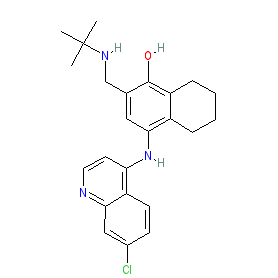GtoPdb is requesting financial support from commercial users. Please see our sustainability page for more information.
|
Compound class:
Synthetic organic
Comment: Naphthoquine is a 4-aminoquinoline antimalarial compound.
The marketed formulations contain naphthoquine phosphate (PubChem CID 9851774). The Malaria tab on this ligand page provides additional curator comments of relevance to the Guide to MALARIA PHARMACOLOGY. |
|
|||||||||||||||||||||||||||||||||||
| Guide to Malaria Pharmacology Comments |
| Naphthoquine was first synthesized in 1986 in China (during an extension of Project 523) and developed for clinical use during the 1990s [3]. Potential Target/Mechanism Of Action: As the precise MOA of naphthoquine is not yet known, we do not have a molecular target for this compound. It is thought that naphthoquine has a similar MOA to other 4-aminoquinolines such as chloroquine, killing the malaria parasite by causing a build up of toxic heme by inhibiting the enzyme that normally converts it to non-toxic haemozoin [1]. |








